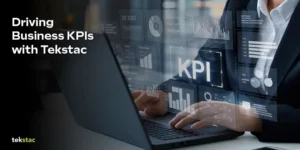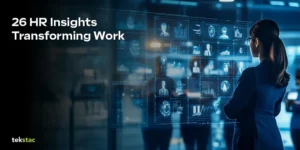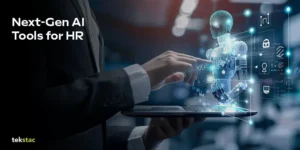8 Proven Strategies for AI-Driven Workforce Planning
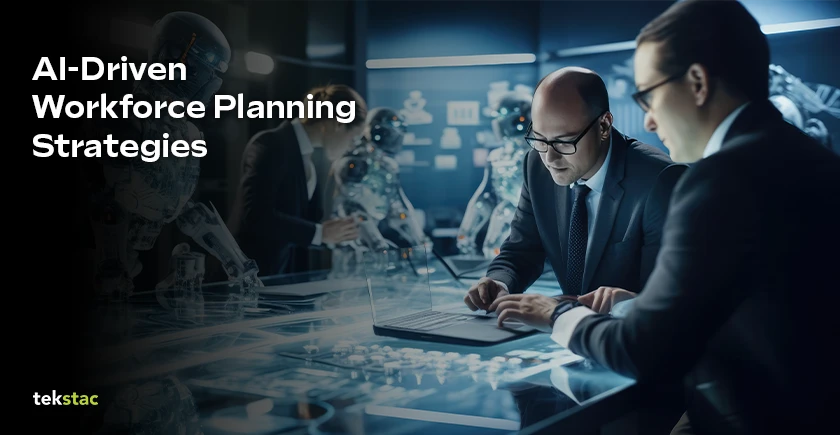
What Is Workforce Planning in the Age of AI?
A new chapter of work is unfolding, one where intelligence isn’t just human anymore. Automation is no longer limited to manufacturing lines; it is now influencing decisions in boardrooms, creating efficiencies in customer service, and powering the tools we use to design, write, market, and build. Amid this digital surge, organizations are under immense pressure to future-proof their workforce, and those that fail to adapt risk falling irreversibly behind.
Workforce planning, once centered around static job descriptions and annual headcount forecasting, has evolved into a living, breathing discipline. Today, it requires a sharp lens into market disruptions, a granular understanding of skill demand, and the foresight to align talent with transformation.
AI isn’t coming- it’s already here. The real question is.
How do we plan for a workforce that’s ready for it?
Workforce planning is the strategic process of aligning an organization’s talent supply with its future business needs. In the AI era, it involves analyzing skill gaps, predicting future roles, and integrating automation insights to ensure the right people, with the right skills, are in the right place at the right time.
Why Traditional Workforce Planning Fails in the AI Era
For decades, companies operated on predictable cycles. Job roles stayed the same, learning happened in classrooms, and promotions followed tenure. But with AI integrating into core business processes, change has become exponential. Roles like “AI Trainer,” “Prompt Engineer,” and “Ethical Technologist” didn’t exist five years ago. Now, they’re critical.
According to the World Economic Forum’s Future of Jobs Report 2025, employers anticipate that 39% of workers’ core skills will change by 2030.
This shift is expected to result in the displacement of 92 million jobs, while simultaneously creating 170 million new roles, leading to a net increase of 78 million jobs globally.
Organizations clinging to legacy workforce planning models are struggling. These models assume that tomorrow’s roles will look like today’s—and they won’t. Roles will continue to dissolve, combine, or morph into hybrid jobs that require human judgment alongside machine intelligence.
Planning for static roles has become planning for obsolescence. The modern approach must center on capabilities, adaptability, and ecosystem thinking.
8 Proven Workforce Planning Strategies for the AI-Driven Future
- From Jobs to Skills: The Language of the Future
- Workforce Intelligence: Seeing Around Corners
- Learning as the Currency of Transformation
- Agility over Stability: A New Workforce Philosophy
- Leadership Reimagined
- Internal Mobility as a Strategic Engine
- Equity at the Core of Planning
- Preparing the Next Generation
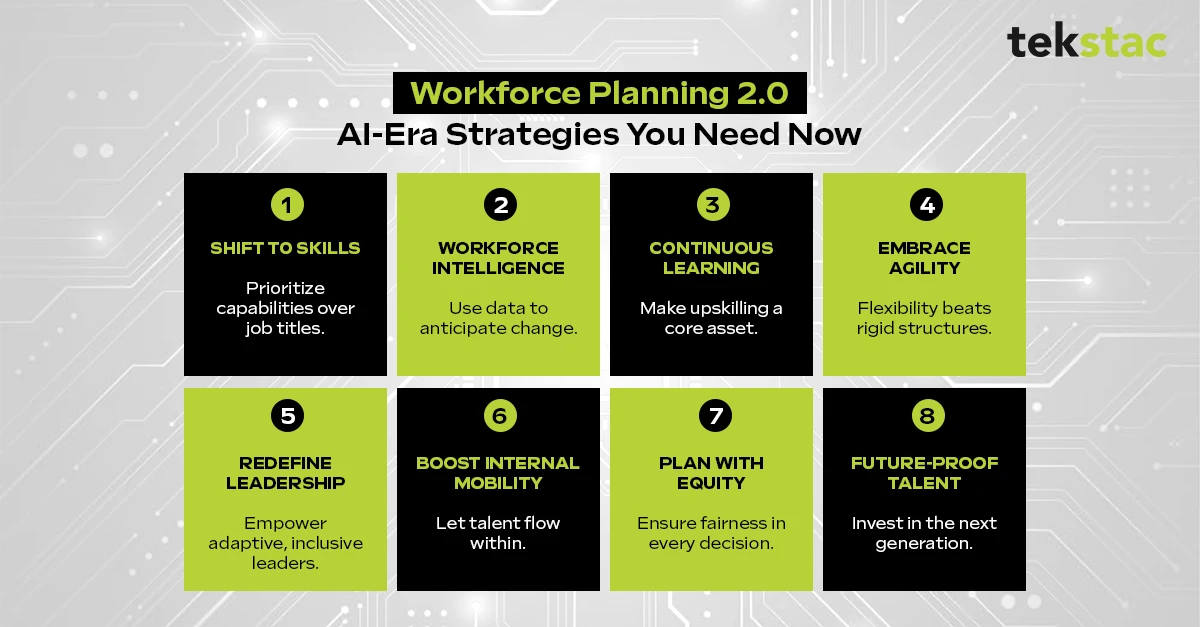
1. From Jobs to Skills: The Language of the Future
The future doesn’t speak in job titles, it speaks in skills. The shift from role-based to skill-based planning is one of the most defining features of workforce transformation.
According to a McKinsey Global Survey, 87% of executives say they are experiencing skill gaps in the workforce or expect them within a few years.
Companies that once hired for predefined roles are now deconstructing them into component skills. A “Sales Manager” may need a blend of customer empathy, data analysis, CRM automation, and generative AI knowledge. These skill clusters enable flexible deployment across multiple use cases, transforming people into assets who evolve as fast as the business does.
The most resilient organizations are building detailed skill taxonomies, continuously analyzing gaps, and fueling internal mobility by aligning learning pathways with emerging demand.
This is not about filling vacancies- it’s about future-proofing talent at the molecular level.
2. Workforce Intelligence: Seeing Around Corners
In an AI-dominated landscape, information is power, but insight is everything. Advanced workforce planning now relies on real-time data, AI-driven forecasting models, and skill heatmaps that predict where growth or decline is likely to happen.
This new skills intelligence helps organizations look beyond the next quarter and plan for the years ahead. It allows leaders to anticipate disruptions, identify at-risk functions, and act before the market does.
Workforce planning isn’t reactive anymore. It’s anticipatory, strategic, and deeply integrated with how organizations approach innovation, mergers, technology upgrades, and global expansion.
Data-backed planning doesn’t just reduce risk, it creates a competitive advantage.
AI’s Impact on Workforce Planning
- AI redefines workforce planning through predictive forecasting, real-time skill mapping, and automation.
- It helps leaders anticipate talent gaps, align learning with emerging roles, and make faster, data-driven decisions.
- By integrating AI insights, organizations move from reactive headcount management to proactive talent strategy—creating a workforce that evolves as fast as technology itself.
3. Learning as the Currency of Transformation
In the age of AI, learning agility has become the new corporate currency. Companies that embed continuous learning into their DNA are building workforces that can pivot, scale, and lead through uncertainty.
The learning paradigm is also changing. No longer confined to annual workshops or lengthy courses, the future of learning is fast, flexible, and integrated into the flow of work. Microlearning modules, AI-recommended content, skill simulations, and just-in-time knowledge delivery are becoming the new norm.
Organizations that prioritize learning are no longer asking, “What should we train our people on?” but rather, “How do we create an environment where learning never stops?”
This cultural shift redefines talent strategy—from acquiring skills externally to cultivating them internally.
4. Agility over Stability: A New Workforce Philosophy
Stability used to be the hallmark of successful planning. Today, agility reigns supreme. Workforce planning in the AI age demands the ability to reconfigure teams, redeploy talent, and rethink structures with speed.
Cross-functional teams, project-based work, and skill-sharing networks are replacing rigid hierarchies. The gig economy, freelance platforms, and talent clouds are allowing organizations to dynamically tap into external capabilities when needed.
Success now lies in how quickly a company can reassemble its talent around an opportunity.
This shift isn’t just structural, it’s psychological. It means fostering a mindset across leadership and the workforce that embraces ambiguity, experimentation, and reinvention.
5. Leadership Reimagined
Workforce planning cannot thrive without leaders who understand transformation. In the AI era, leadership is no longer about control, it’s about navigation.
Leaders must guide their teams through ethical dilemmas, reskilling initiatives, AI adoption fears, and complex change cycles. They must inspire confidence while acknowledging uncertainty. And perhaps most importantly, they must lead with empathy.
AI may enhance performance, but only humans can drive culture. Leaders who understand this balance are not just technology champions, they’re people architects.
Future-ready leadership isn’t technical; it’s transformational.
6. Internal Mobility as a Strategic Engine
In a market where skill shortages are the new normal, internal mobility is one of the most underutilized tools in workforce planning. Companies already sit on goldmines of untapped potential, employees who, with the right upskilling, could transition into high-demand roles.
Progressive organizations are building talent marketplaces that allow employees to self-navigate toward growth. AI algorithms suggest internal opportunities based on skill fit, career aspirations, and business need, creating a dynamic ecosystem of movement, growth, and engagement.
This isn’t just good HR, it’s good economics. It reduces hiring costs, boosts retention, and cultivates a more future-ready workforce from within.
7. Equity at the Core of Planning
As AI reshapes work, inclusion must be non-negotiable. Historical biases in data, unequal access to learning, and algorithmic decision-making can all exacerbate existing workplace inequities if left unchecked.
Strategic workforce planning in the AI era must be intentionally inclusive. That means designing systems that account for fairness, ensuring diverse perspectives in AI training datasets, and democratizing access to upskilling programs.
Organizations that embed equity into their planning are not only doing the right thing, they are creating environments where innovation thrives, talent flourishes, and risk is reduced.
The future must be fair or it won’t be sustainable.
8. Preparing the Next Generation
The implications of AI-driven workforce planning don’t stop with current employees. They extend to schools, colleges, and the way we prepare our children for careers that don’t yet exist.
The OECD estimates that 1.1 billion jobs are liable to be radically transformed by technology in the next decade.
The next generation must be equipped not just with coding skills but with curiosity, adaptability, ethical reasoning, and creative problem-solving. Parents, educators, and companies alike have a role to play in bridging the skills of today with the possibilities of tomorrow.
The career ladder has been replaced by a career lattice. Students of today will not have a single job for life, they’ll likely have multiple careers, across domains, augmented by machines, but driven by human values.
If workforce planning is the compass for organizations, career readiness is the compass for individuals.
The Future of Workforce Planning: What Comes Next?
The rise of AI isn’t just an industrial revolution- it’s a human one. And like every revolution, it requires bold thinking, new tools, and a reimagined vision for how we build and sustain workforces.
Effective workforce planning in the AI era is about more than numbers on a spreadsheet. It’s about enabling people to grow, adapt, and lead in a world where change is constant. It’s about creating alignment between business ambition and human capability. And above all, it’s about ensuring that as machines rise, so too does our collective capacity for innovation, empathy, and progress.
The future of work is not being built in the future. It’s being built now. And those who plan wisely will shape it.
FAQs on Workforce Planning
1. Why do we do workforce planning?
Workforce planning helps organizations align talent supply with future business goals. It ensures that the right people, with the right skills, are in place to meet changing market demands and strategic priorities.
2. How is AI changing workforce planning?
AI enables real-time skill analysis, predictive forecasting, and smarter talent deployment. It transforms workforce planning from reactive headcount management into a proactive, data-driven strategy.
3. How does AI help in strategic workforce planning?
AI analyzes large volumes of talent, market, and performance data to predict future skill requirements and guide smarter hiring, training, and mobility decisions.
4. What are the challenges in AI workforce planning?
Common challenges include data quality issues, bias in AI models, limited integration across HR systems, and lack of workforce analytics skills.

